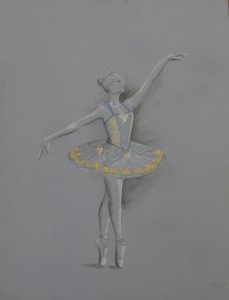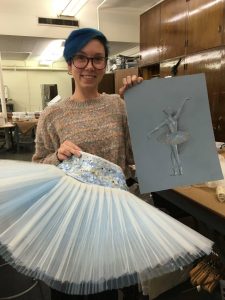A performance during the Illinois State University Dance Theatre’s 2017 Fall Dance Concert showcased a ballerina tutu designed and constructed by Amanda Vander Byl.
Vander Byl, a third-year graduate student in the M.F.A theatre-costume design program, has always dreamed of having the opportunity to construct her very own classical ballerina tutu.
When a ballet production is being planned for in professional dance companies, it is typical for the entire costume shop to be dedicated to creating the gorgeous tutus that are seen onstage. The tutu that Vander Byl constructed was completed entirely by herself, as an independent study.
The chance to create the tutu was many years in the making, beginning first with a conversation with dance instructor and choreographer Gregory Merriman expressing her desire to do the project.
It took nearly two years from that conversation before Merriman determined that he had selected the right ballet, and lead ballerina, to work with a classical tutu. Vander Byl then started working toward creating the tutu for dancer Ekaterina Everhart for the wedding scene of the ballet Coppélia.
A grant from the Friends of the Arts supported Vander Byl in her endeavor, providing funds to help her purchase sewing patterns, fabric, notions, and instructional books, including The Classical Tutu Book by Claudia R. Folis. Working on her own time, Vander Byl learned how to construct a classical tutu.

Rendering of classical tutu, created for the 2017 Fall Dance Concert by Amanda Vander Byl.
To begin the process, Vander Byl created a rendering. Merriman gave her complete and total freedom for the design. Vander Byl decided to create a very detailed tutu design. She decided on a color scheme of periwinkle, gold, and ivory, suggesting a bridal theme, but one that is not overtly traditional.
“A tutu without detail takes 15–20 hours to create. A professional costumer designer making a detailed tutu can do it in 30 hours. I originally estimated my tutu would take close to 60-plus hours to create,” Vander Byl said.
Taking the whole process step-by-step, she began by creating sets of the costume for sizing Everhart, since the final fabric can only be cut once. Vander Byl chose a fabric that was stretchable and can fit up to 3 inches bigger than Everhart’s sizing. This will allow the tutu to be used again in the future.
The professional classical tutu that Amanda desired to create is called a pancake tutu. A pancake tutu is made with several layers of pleated tulle and lies flat, projecting out from the dancer, whereas with other types of tutus, the fabric drapes down toward the floor. In creating her tutu, Vander Byl had to iron out each pleating individually. With nine layers of pleating, Vander Byl estimates that the process of pleating alone took her close to 16–18 hours.
As the date for the Fall Dance Concert approached, Vander Byl was under a lot of pressure to complete the sewing in order to meet the deadline for the tutu. As she watched her tutu onstage for the first time during the dress rehearsal, she said that she was at the edge of her seat hoping it would hold together and do what it was supposed to do, “allowing Everhart to dance comfortably, displaying the movement of the ballerina and supporting the story being told within the performance.”

Amanda Vander Byl with her completed tutu and original rendering.
All of Vander Byl’s hard work paid off, as her tutu dazzled under the stage lights.
Amanda surpassed her 60 hours to create the tutu and estimates that the process took closer to 80–90 hours to complete. She stated that the tutu is by far the prettiest thing she has created so far, and will probably ever create again. Looking back on her time spent as a whole, she saw the whole process as very beneficial, but would likely do things differently if ever given the opportunity again.

